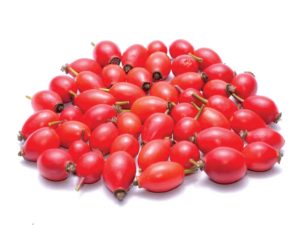
The wild rosehips (rosa canina) adorning our hedgerows at the moment have a wide array of medicinal and culinary uses. Well known for their high vitamin C levels (over 20 times more than oranges per 100g) they have been a staple children’s supplement for centuries in the form of rose hip syrup.
Boiling them can reduce the nutritional and medical value by half though, so I thought I’d share some other ways of harnessing their health benefits.
What are Rosehips good for?
A number of recent studies have focussed on rosehips’ ability to modulate inflammation and reduce pain. Several of these showed that patients with osteoarthritis in hips or knees benefitted from a daily doses of rope hips.(1)
Another study showed reduction in PMS symptoms in women drinking rose tea daily. (2)
The astringent power of rosehips, due to the tannin content, means that they are good for toning loose tissue such as when teeth become loose in gums or when the intestinal tract is irritated by diarrhoea. (3)
The threefold actions – supporting immunity, helping elimination and cooling – make rose a superb natural reliever of cold and ‘flu symptoms (4)
Three ways to use Rosehips
Fresh from the bush
Drying and cooking lower the Vitamin C content of rosehips, so for the most benefit eat them fresh. Wait until after the first frost for a softer, sweeter taste, then simply bite or cut them in half, remove the seeds and seed hairs with your thumbnail, and eat the red bit. Be careful not to eat the irritating hairs.
Rosehip Brandy (makes a great Christmas present if you start now)
This is a super-easy way to extract the goodness of rosehips. Half fill a jar with washed whole hips (no need to prepare them in any way) and fill to the top with a good brandy. Seal the jar with a tight fitting lid and store for 3 months out of direct sunlight, shaking occasionally. When the brandy turns pinky-red and takes on the flavour of the rosehips drain off the liquid and bottle. I can recommend a spoonful of this on cold winter days!
Rosehip Powder

The hips release more of their goodness once they have been in a frost, but as our first frost can be late in the season these days, it’s easy to replicate this effect by gathering them as soon as they are ripe and then freezing for 24 hours (no longer).
Next, spread them on paper and dry them on a sunny window sill or in an airing cupboard or dehydrator. Once they’re dry, blitz them in a food processor until you have small chunks, but not too small to go through a sieve.
Then sieve the rosehips pieces, shaking gently onto a newspaper until the irritating seed hairs have been removed. It’s really important to remove these, so keep going until you see the dust and hairs on the newspaper, taking care not to breathe any in as you work.
Lastly, blend your rosehip pieces to a powder and store in a sealed jar.
This can be sprinkled on food, mixed into yoghurt, used in sweet or savoury recipes or made into a herbal infusion by adding a spoonful to boiling water.
Studies showing medicinal benefits of rose hips have used dosages anywhere from 5 grams to 45 grams per day. (5)
Notes:
- (1) This Journal article also has links to similar trials: A powder made from seeds and shells of a rose-hip subspecies (Rosa canina) reduces symptoms of knee and hip osteoarthritis: a randomised, double-blind, placebo-controlled clinical trial – https://pubmed.ncbi.nlm.nih.gov/16195164/
- (2) & (3) Alchemy of Herbs by Rosalee de Floret page 232
- (4) Hedgerow Medicine by Julie Bruton-Seal and Matthew Seal, page 197
- (5) Alchemy of Herbs by Rosalee de Floret page 233